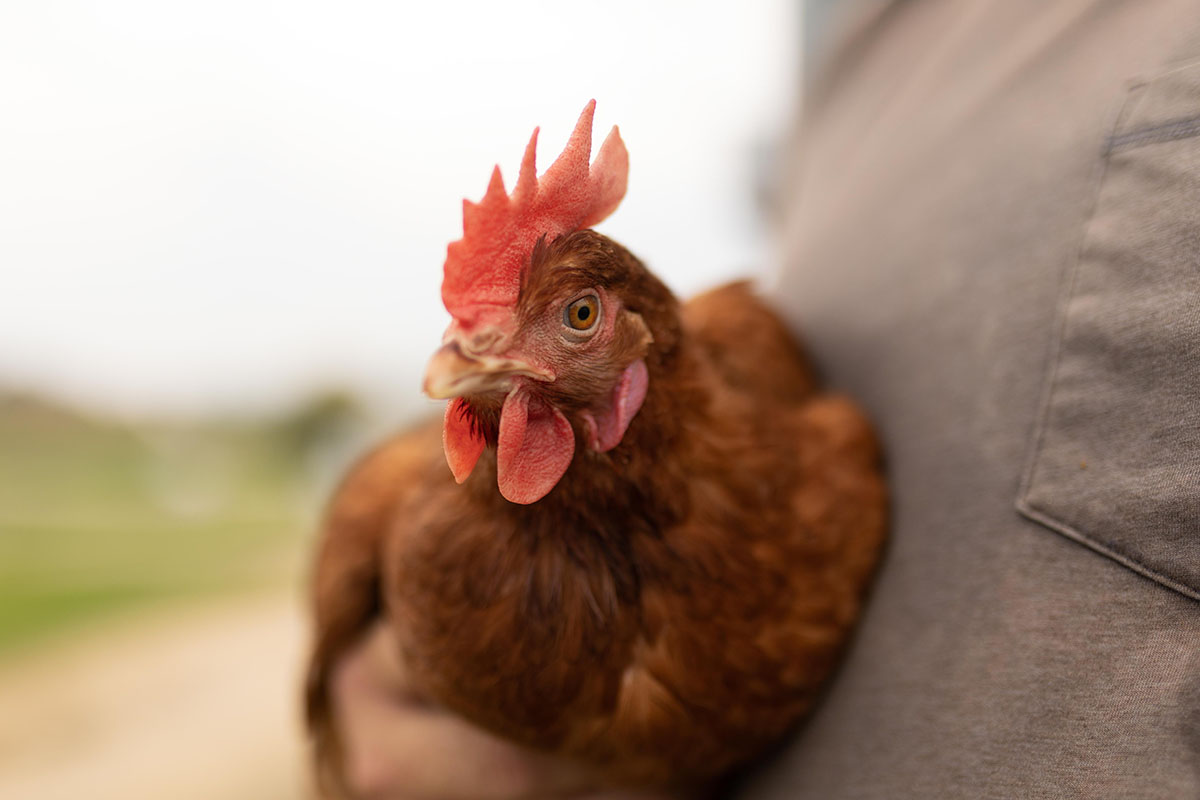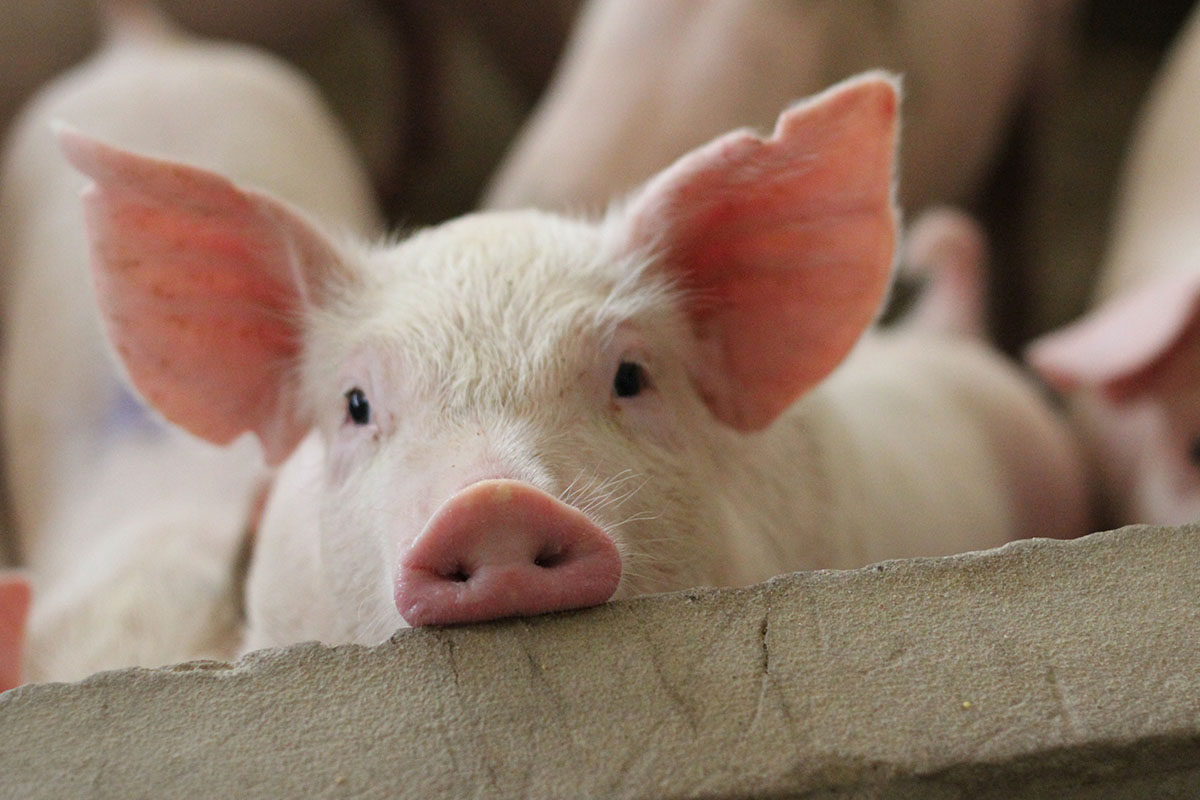
(Photo: Joclyn Bushman/Iowa Soybean Association)
Soy Spotlight
November 2, 2021 | Bethany Baratta
U.S. soybeans are not only sold to global customers via whole beans or crushed soybean meal, but to U.S. meat, poultry and egg producers.
Soy packs a powerful protein punch, which makes it a preferred choice for livestock growers domestically and abroad. The Iowa Soybean Association’s investments through various partnerships help reach more customers globally, thus sharing the soybean story and ultimately selling more soybeans.
Mac Marshall, vice president of market intelligence for the United Soybean Board (USB) and U.S. Soy Export Council, says these investments grow global opportunities.
“We enjoy strong market share as a provider of soybeans, soy meal and oil because we made the early-stage investment to market, promote and teach — to have the knowledge transfer and capacity building,” he says.
Through the “Dare to Compare” marketing campaign, the world is learning about the value U.S. soy delivers with its nutritional profile, sustainability and other characteristics.
“We’ve had success showcasing U.S. soy to nutritionists, formulators and buyers in overseas markets by demonstrating that U.S.-origin soybeans or soybean meal provides superior animal performance,” Marshall says.

'Gobbling up soy'
The largest user of U.S. soybean products is the livestock industry, according to USB, with the poultry sector gobbling up more than half of U.S. soybeans each year.
Iowa is the largest egg-producing state in the nation. Iowa’s poultry and egg exports translate into 2.1 million bushels of soybeans, according to the USA Poultry and Egg Export Council (USAPEEC). In the U.S., domestic usage by the poultry and egg industry reached more than 1 billion bushels.
The U.S. poultry industry exported more than 4 million metric tons of poultry and egg products in 2020, equivalent to 148 million soybean bushels.
“Increasing demand for poultry outside of the United States creates opportunity for both U.S. poultry and egg exports as well as local poultry production, which creates opportunity and demand for U.S. soybeans,” says Jim Sumner, USAPEEC president and CEO. “A rising tide floats all boats.”
Mexico is the top market for U.S. chicken, turkey and eggs. In 2020, egg exports to Mexico hit 6 million dozen, up 238% from 2019.
The Iowa Soybean Association (ISA), through its financial contribution to USAPEEC, is helping to create more demand for U.S. soy specifically through a program in Mexico.
The program works with the egg product processing industry in Mexico to create more ready-to-eat egg products. USAPEEC expects poultry and egg ingredients used in the new products to increase by at least 100 metric tons annually, creating additional demand for soybeans in the process.
There doesn’t seem to be a slowdown in sight for U.S. broiler exports, which hit a record 2.15 million metric tons in exports the first half of 2021. This means expected growth in soybean exports through broilers.
“We contribute the growth in exports to a good soybean diet,” Sumner says. “That’s exactly what it is. We talk about chickens and turkeys as soybeans with wings.”
Soybean meal is vital to poultry because of its digestibility and amino acid profile, USAPEEC notes. Soybean meal inclusion rates for poultry feed are more than 26% for broilers, 19% for laying hens and 31% for turkeys.
Pork exports
In 2020, U.S. pork exports set a record at 3 million metric tons, driven by purchases from China as the country battled African swine fever (ASF) in its domestic hog herd. Pork demand from China softened toward the end of the year as it began rebuilding from ASF, but pork exports have remained strong globally, says Joe Schuele, vice president of the U.S. Meat Export Federation (USMEF).
“We’re pretty confident we can match the performance in 2020 because we’ve always focused on market diversification,” Schuele says.
U.S. pork exports to Mexico and Central America are on a record pace this year, while demand has also strengthened in Japan, South Korea, Colombia and the Philippines.
Every pound of U.S. pork exported represents the utilization of about 0.91 pounds of U.S. soybean meal. Considering the soy utilization rate, Iowa’s ranking as the top pork producing state in the country, and the availability of soybeans, ISA’s investment in USMEF is well placed.
“It’s very forward-looking for soybean farmers to understand who their market is and to understand that to have strong demand for their product, Schule says.
“They have to look at how the product is used and how to keep the U.S. livestock industry growing and vibrant,” he says. “Soybean industry leaders see red meat exports as a real catalyst for growth and profitability in the livestock industry.”

Growing opportunities
Soybean meal comprises about 50% of aquaculture diets. (It’s the most used protein source in aquaculture feeds worldwide.) Because soybean meal is high in protein and readily digestible, it’s a valued feed for aquaculture growers.
“The aquaculture industry is growing fast across the world, and it’s become an important demand driver for soybean meal,” says ISA District 9 Director Tom Adam from Harper.
The U.S. is a net importer of fish, but the aquaculture business is growing, says Kenlon Johannes, executive director of the Soy Aquaculture Alliance.
ISA’s investment in the alliance helped spur the growth of global aquaculture systems and soy demand.
For example, investments in the In-pond Raceway Aquaculture systemin China in 2017 helped modernize and expand the country’s aquaculture industry, and the technology is spreading to other countries. Using this technology in the U.S. could build domestic aquaculture production, Johannes says.
Any demand is good for Iowa’s soybean farmers, says Adam, who also serves as treasurer for the Soy Aquaculture Alliance.
“While aquaculture might be not be big in Iowa, global aquaculture is important to Iowa soybean farmers because of the potential.”
Aquaculture production is projected to reach 109 million metric tons in 2030, up 32% over 2018, according to the Food and Agriculture Organization.
Helping farms grow
Helping farmers grow their livestock farms builds demand for soybean products. That’s why ISA’s investment in the Coalition to Support Iowa’s Farmers (CSIF) makes sense. Since 2004, CSIF field coordinators have helped more than 4,900 Iowa farm families determine the best location for livestock barns, being mindful of rules, regulations and neighbors.
ISA’s investment in CSIF means farm visits are available to farmers confidentially and at no cost.
“The investment from the Iowa Soybean Association is going toward helping the livestock industry grow, often bringing the next generation of farmers back to the farm,” says Brian Waddingham, CSIF executive director.
A one-stop shop for Iowa’s livestock farmers, CSIF connects them with the most up-to-date rules and regulations regarding livestock farming, opportunities to recognize their peers for being good neighbors, and assistance in replacing or adding a windbreak or vegetation to their farm. The Coalition also hosts events for farmers to learn about the opportunities in Iowa agriculture including an aquaculture conference slated for January 2022. For more information, go to www.supportiowasfarmers.com.
Back